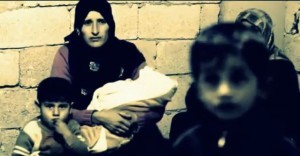A War of Songs between Opposition and Regime Supporters in Syria

By Mariam Abdullah*
Nohad al-Tawil bid farewell to 2013 by dancing with her family and friends to a song called “Ya Boshama,” which means “Oh Handsome One” – a song by Bahaa Youssef and lyrics by Ali Aloush. Nohad, 40, recently married a man of Syrian origin who immigrated to Germany a number of years ago.
“It’s an amazing song that asserts that we’ll always stand behind Assad,” she said in a conversation over Skype. “It riles you up and gives you a feeling of power and belonging to [Syrian President] Bashar [al-Assad] and Maher’s [al-Assad] leadership.”
At almost the same time

, electrical engineer Wael Saeed, 32, was ringing in 2014 to the sounds of “Janna Ya Watanna,” which means “Our Homeland is a Heaven,” a song Wael claims is best suited to celebrating the year past. Its lyrics, he explained, despite their sadness, are fundamentally revolutionary, especially that they are sung by Abdel Basset Sarout, a Syrian folk sports hero and one-time goalkeeper for the Al-Karama football team who is now trapped in the besieged city of Homs.
All types of Syrians celebrated the New Year with song – something that Syrians on all sides of the political spectrum have in common. Many songs are political and are held dear by one side of the other. Some songs praise the regime, others support the opposition. The lyrics present the situation from each different perspective, showcasing the transformations society has undergone, and are accompanied by stirring nationalist and popular melodies. Each side seeks to deploy their songs in the psychological war against the other.
Some regime supporters embrace songs that are strongly nationalist, such as Moudi al-Arabi’s song, “Ana Raje’ ala Souria,” which means, “I am Coming Back to Syria.”
Opposition songs tend to forgo glorifying specific individuals in order to focus on loss and departure, such as “Ya Beiti Shou Ishtaqtillak,” (My House, How I Have Missed You), sung by Ribal and written by Rami al-Asheq. The song talks about displacement, asylum and nostalgia for land and home; it also talk about the longing to return to a place and time now destroyed by the conflict.
The two sides seem to compete to see who can hook more listeners emotionally by moving them to tears. The regime’s side scored a victory with a song by Uthaina al-Ali that contained these lyrics:
“Oh, mother Syria, hide your tears, for they will water you when you have thirsted from the spill of precious blood.”
The lyrics emphasize the idea of sacrifices both big and small made for the sake of the nation. During a televised interview, Ali said that the Arab revolutions are only virtual, and that what is happening in Syria is not political, and that the real opposition ought to stand with the government and criticize its mistakes from within, for what is actually happening in the street is targeting Syria both existentially and historically.
One of the songs released by the opposition, entitled “The Free Army Calls,” is an upbeat, encouraging song.
“It distances itself from the idea of glorifying individuals, the way the songs of the regime celebrate the president, exalting his brave spirit and his family,” according to Rana al-Abdlaki, a social worker. “The opposition songs have done away with lionization of a specific person and have, until now, avoided manufacturing any heroes.”.
But the regime was quick to follow suit in this regard, upping the ante for nationalist sentiment, such as in the song “Souria Mawjou’a” (Syria is in Pain) by Shadi Aswad. The competition is fierce between the songs, despite the situation and an outward appearance of support, according to a music producer who introduced himself as Hassan, 31. Hassan has helped produce many of the revolution’s songs, including “Janna Ya Watanna.”
“In many of the Syrian districts, the songs are usually inspired by the street and their tone by the dialect of the area, which is why they have been so successful,” Hassan said. “We were able to see people interact with the songs directly, and see how some of them, like the sectarian songs, didn’t resonate with many people.”
He explains that revolutionary songs talk about the opposition’s refusal to be oppressed and humiliated and reiterates demands for freedom. Hassan says that here is also large discrepancy between the financial resources available to those recording songs that glorify the regime of Bashar al-Assad and those that oppose it.
“We were recording songs on a home computer in a small room in someone’s house, using very basic microphones that don’t really pick up any of the details in terms of sound or voice recording, then releasing the songs on YouTube by ourselves,” he said. “The regime songs are recorded in the most well-equipped studios, using the best sound equipment and are most often released accompanied by a video clip and are freely broadcast on most of the local stations, both television and radio.”
Jamal Khalil, a psychologist and lecturer in psychology, has found certain elements that commonly appear in each sides’ songs: pro-regime songs, for example, usually speak of Syria’s past, name-checking the president every now and again, accompanied by videos that show government forces decked out in military regalia. Most of the lyrics are quite sentimental, evoking the idea of sacrifice; most contain the word “blood.” There is a diversity of musical styles, from the folklore of the coast to rap and other various rhythms. He adds that the songs that glorify the regime’s army are usually faster and more upbeat, accompanied by images and videos designed to invoke an emotional, patriotic response. Many of the songs portray Bashar al-Assad as a brave defender and wise leader of the nation.
On the other hand, the psychologist points out that most of the revolution’s songs are about suffering, drawing attention to the tragedy of destroyed cities and wounded children, accompanied by real footage from areas under bombardment. The videos show the human toll: of mothers, children and refugees, with less invocation of Syria as a whole.
Most of the pro-revolution songs are quite modern, forgoing traditional tunes in favor of more modern rhythms, often using rap and different sound effects. Images of violence are much more prevalent.
The social worker Rana al-Abdlaki considers Ibrahim al-Qashoush’s song to have marked the beginning of a real revolutionary transformation in art.
“It turned the words and slogans that have, for decades, been used to praise the leader and his immortality into words that curse and condemn him, as if wiping away a whole history of refrains that brainwashed generation after generation, and that’s what scared the regime into releasing their own songs, copying Qashoush, to use them in their pro-government parades,” she said.
Abdlaki adds that the melodies themselves have chronicled the evolution of the conflict, and the suffering now is such on both sides that it has led, today, to the worst of sectarian sentiment being showcased in song. One can hear these songs even in the heart of Damascus, such as “Al Ghadab al Alawi Yatafajjar” (Alawite Rage is Exploding). In opposition areas, says Abdlaki, the equivalents to such songs are those that incite revenge in the name of Islam and jihad.
*A pseudonym for a reporter living in Syria.
